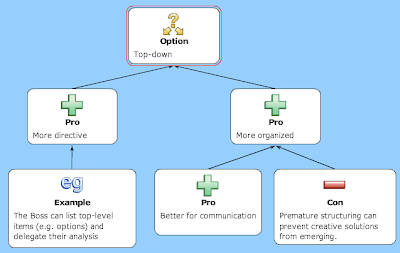Top-down and bottom-up thinking are complimentary. Let’s see why:
 The alternatives (all images produced in bCisive Online)
The alternatives (all images produced in bCisive Online)Both top-down and bottom-up thinking cut across the critical / creative thinking divide:
Critical thinking
- Structuring and categorizing (mainly bottom-up)
- Hypothesis testing (top-down)
- Argument mapping (top-down and bottom-up aspects)
Creative thinking
- Brainstorming (bottom-up)
- Mind-mapping (top-down)
- Dialogue and issue mapping (top-down)
Let’s look at what’s good about each in visual form:
 A combined approach
A combined approach
The pertinent “higher level” thinking skill is knowing which tool — top-down or bottom-up? — to use for which job.
As with all techniques, practising the skills is important — first learn the rules of the game, follow them until they become internalized, then understand the limits of the rules and where to break ’em — and then you can enjoy the benefits of these complimentary approaches.


